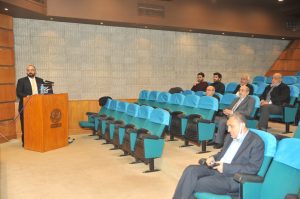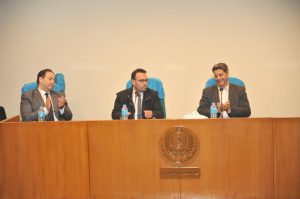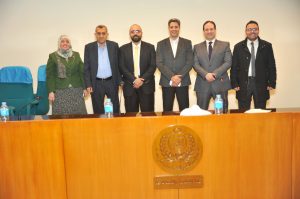Experimental Investigation of Wave Energy Extraction Systems
Masters of science (MSc) 2022
By
Abdullah Hamed Wanis Harby
Supervisors
Prof. Dr. Ahmed A. Hanafy
Mechanical Engineering Department
College of Engineering and Technology
Arab Academy for Science and Technology and Maritime Transport
Ass. Prof. Ahmed S. Shehata
Marine Engineering Department
College of Engineering and Technology
Arab Academy for Science and Technology and Maritime Transport
Mechanical Engineering Department
College of Engineering and Technology
Arab Academy for Science and Technology and Maritime Transport
Abstract
Wave energy has great potential to solve the unrelenting energy deficiency in Egypt. It has zero emissions and is therefore environmentally friendly energy. It can be used at any time as it is renewable energy. Wave energy is a suitable renewable energy extracting mechanism in a world determined to achieve carbon emissions. Egypt is one of the countries with certain shoreline distances with appropriate wave characteristics on the Mediterranean and the Red Sea. Wave energy has great potential to unravel the unrelenting energy deficiency in Egypt. It’s zero emissions and is therefore environmentally friendly energy. It is often used at any time because it is renewable energy.
In this thesis, the relationship between well turbines and wave energy is studied as a suitable option for the coast of Egypt. However, Egypt has extensive coastlines on the Mediterranean and the Red Sea. Both experimental and mathematical analyses were studied. A comparison between different airfoil types in bidirectional flow arranged in the experimental setup. The setup consists of a reciprocating piston that compressed the air in the laboratory instead of wave motion. In the mathematical model, the starting and running characteristics of the wells turbine are studied by changing the starting rotation speed, starting load on the system, and changing the mean rotor radius of the rotor. NACA0015 turbine profile is proven to give the highest rotational speed better than NACA0012 by 7%. The 4 slots also had more exciting results than the one and three slots; the inclined slot improved the flow efficiency.
During the second part, the connection between point absorber device and wave energy was studied as an appropriate option for the coast of Egypt. Both experimental and mathematical analyses have been studied. In the experimental setup, a comparison between different body shapes is arranged. The setup consists of a floating buoy in the laboratory to interact with wave motion. In the mathematical model, the starting and running characteristics of the point absorber are studied by changing the body shape. Results showed that shape number 4 had the maximum oscillations, improving power generation.
Published Papers
A.H. Harby, Shehata, A.S., Afify, R.S., Hanafy, A.A., “Experimental Investigation for Suction Slots of Wells Turbine and Shapes of Point Absorber”, Energy Reports, vol. 8, pp. 1275-1287, 2022.
A.H. Harby, Shehata, A.S., Afify, R.S., Hanafy, A.A., “Experimental Investigation for Suction Slots of Wells Turbine and Shapes of Point Absorber”, Technologies and Materials for Renewable Energy, Environment and Sustainability, TMREES21Gr Int’l Conf. Paris – France, 9-11 May 2022. Certificate
A.H. Harby, Shehata, A.S., Afify, R.S., Hanafy, A.A., “Experimental and Mathematical investigation of Wells Turbine under bi-directional flow”, Technologies and Materials for Renewable Energy, Environment and Sustainability, TMREES21Gr Int’l Conf. Athens – Greece, 28-30 May 2021. Certificate



